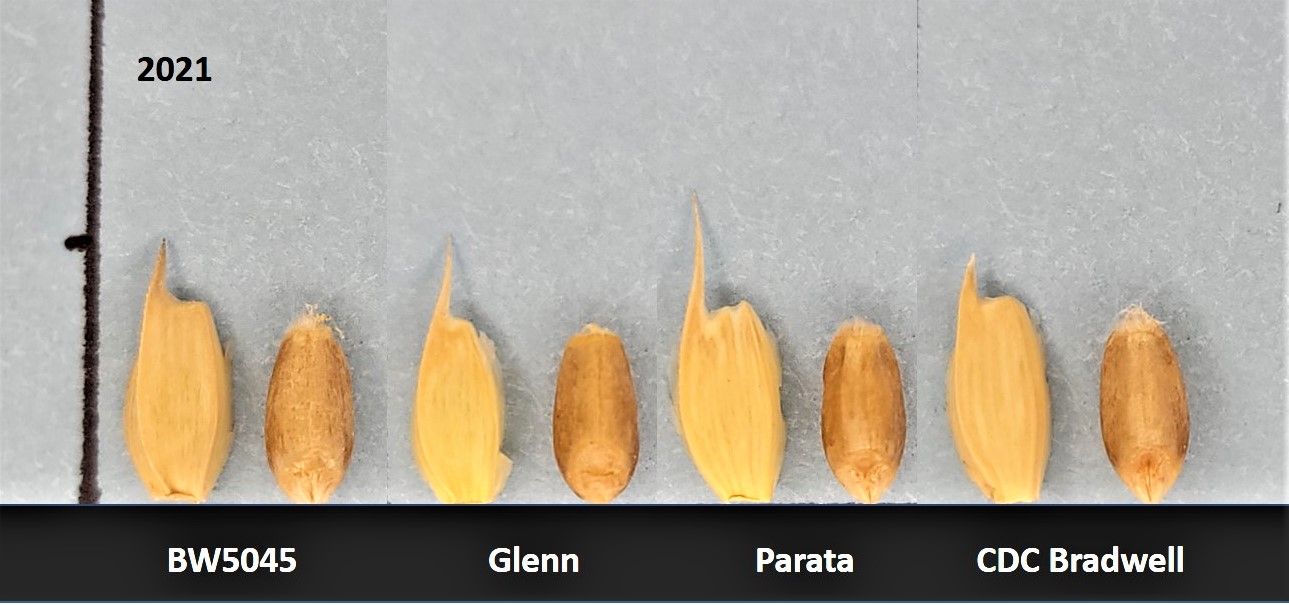CDC Silas
| Denomination: | 'CDC Silas' |
|---|---|
| Botanical Name: | Triticum aestivum |
| Applicant/Holder: |
University of Saskatchewan Crop Development Centre 4D36 Agriculture Building, 51 Campus Drive Saskatoon, Saskatchewan S7N 5A8 Canada |
| Breeder: |
Pierre Hucl, University of Saskatchewan, Saskatoon, Saskatchewan |
| Application Date: | 2021-04-20 |
| Provisional Protection:: | 2021-04-20 |
| Application Number: | 21-10464 |
| Grant of Rights Date: | 2024-02-07 |
| Certificate Number: | 6996 |
| Grant of Rights Termination Date: | 2044-02-07 |
Variety Description
Varieties used for comparison: 'Glenn', 'Parata' and 'CDC Bradwell'
Summary: At the 4 leaf stage, the coleoptile of 'CDC Silas' has an absent or very weak intensity of anthocyanin colouration whereas that of 'Parata' has a weak intensity of anthocyanin colouration. At booting, 'CDC Silas' has a high frequency of plants with recurved flag leaves whereas 'Parata' and 'CDC Bradwell' have a medium frequency of plants with recurved flag leaves. The flag leaf sheath of 'CDC Silas' has a medium degree of glaucosity whereas that of 'Glenn' has weak glaucosity.
Description:
PLANT: spring type, common wheat, erect growth habit at 5 to 9 tiller stage, high frequency of plants with recurved flag leaves, heads mid-season
SEEDLING (4-LEAF STAGE): absent or very weak intensity of anthocyanin colouration of coleoptile, glabrous sheath and blade of lower leaves
FLAG LEAF: absent or very low intensity of anthocyanin colouration of auricles, medium glaucosity of sheath, glabrous blade and sheath
CULM: medium glaucosity, curved neck
STRAW (AT MATURITY): medium width pith in cross-section, anthocyanin colouration absent
SPIKE: absent or very weak glaucosity at heading, tapering shape in profile, medium density, yellow at maturity, erect attitude, medium density of hairiness of convex surface of apical rachis segment
AWNS: shorter or equal to spike length, white at maturity
LOWER GLUME: medium length and width, glabrous, medium density of internal hairs
LOWER GLUME SHOULDER: medium to broad, straight
LOWER GLUME BEAK: medium to long, slightly to moderately curved
LOWEST LEMMA: straight
KERNEL: hard red type, medium red, medium size, medium length and width, oval shape, medium length brush hairs, crease of medium depth and width
GERM: medium sized, rounded or broad elliptical shape
Origin & Breeding History: 'CDC Silas' (experimental designations 12ORG20 and BW5045) originated from a controlled cross conducted in Saskatoon, Saskatchewan between the variety 'Alsen' and the line W01361 in 2003. The F1 progeny was grown in New Zealand during the winter of 2003-2004. Subsequent generations were grown as bulk plots from 2004 to 2007 in Saskatoon, Sascatchewan. F6 lines were grown as hill plots in 2008 and F7 head rows grown in 2010. Further development was paused in 2009 and 2010 due to a lack of funding. From 2011 to 2015 a line designated as 12ORG20 was tested for reaction to leaf and stem rust and simultaneously grown in replicated yield trails in organic crop rotations in Saskatoon and the University of Alberta in 2012, 2014, and 2015. The line was entered in the Western Bread Wheat 'B' test in 2016 and in the Western Bread Cooperative Test from 2017 to 2019 as BW5045.
Tests & Trials: The comparative trials for 'CDC Silas' were conducted at the University of Saskatchewan, Crop Science Field Facility in Saskatoon, Saskatchewan during the 2020 and 2021 growing seasons. There were 4 replications per variety arranged in an RCB design. Plots consisted of 5 rows, each row 3.6 metres long with an inter-row spacing of 0.23 metres. Measured characteristics were based on 40 measurements per variety per year.
Click on image for larger view

Wheat: 'CDC Silas' (left) with reference varieties 'Glenn' (centre left), 'Parata' (centre right) and 'CDC Bradwell' (right)
- Date modified: